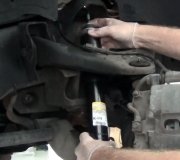If GM can't tell you what they are, you don't need them. That means they are "in-house" codes used by the manufacturer for their reference. They could have to do with production dates, machining processes used, even raw metal supplier. If you really want to know what they're for, you might try contacting Dana or Spicer.
What you need to consider is axle ratio if you want to keep it the same as what you have now, and front-to-rear brake bias. That was carefully designed in to prevent easy rear wheel lockup and even braking on all four wheels. You're going to run into more problems by going to a different year axle. It would by much less hassle if you could find an axle from the same year. One clue that the newer axle WILL work is if the same brake pad part number fits both years. Remember you're going to have to replace the master cylinder with one that doesn't have the residual check valve for the drum brakes, otherwise your new rear disc brakes will never fully release. Disc brakes require a real lot more pressure to apply them so if there is a combination valve on the frame rail right below the master cylinder, or if there is a height-sensing proportioning valve above the rear axle, those are going to be calibrated differently too. Drum brakes are self-energizing. That's why they worked well on big old heavy cars without power assist.
I'm not sure there is any advantage to going to rear disc brakes. Your drum brakes are already capable of locking up the wheels. You can't do too much better than that. Also keep in mind that GM had an extremely miserable rear caliper design with the parking brake built in. Those calipers and pistons are very expensive and real hard to bleed the air because the piston has a chamber that has to be bled. Chrysler, and now finally some Fords use a separate drum brake inside the rotor for the parking brake. Those are real easy to work on. You're going to be in for some misery and frustration in the future with the GM rear calipers.
You should also see if the same part number front AND rear calipers are the same for both years. The diameters of the pistons in the calipers and in the master cylinder are matched for proper pedal response. If you have the "step-bore" master cylinder which GM uses a lot, that might not be compatible with rear disc brakes. To address that possibility, do you order a master cylinder for a '96 model or a 2000 model? Neither one might be correct for both the front and rear. Your life will be a lot easier if the same caliper part numbers were used both years.
Saturday, April 16th, 2011 AT 1:06 AM


